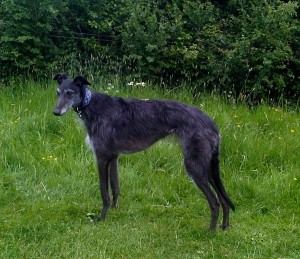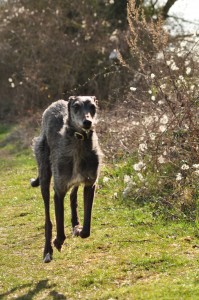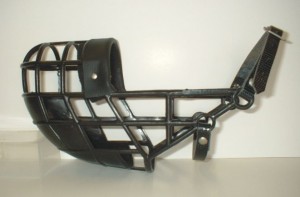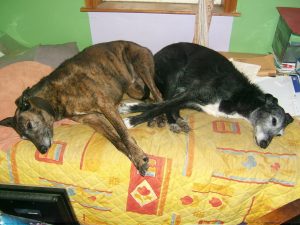Lurchers for Beginners has always been fearless in its expose of the truth about lurchers, and so this time we face up to that stuff they have all over them – fox poo. No, we mean hair, but fox poo will come into it. What is dog hair, why should you care and what might you find in it?
The Hair Itself…
Many lurchers have a single layer of hair, and thus technically have hair coats rather than fur coats. A fur coat on a dog means two layers, the soft linty undercoat and the stiffer topcoat of ‘guard’ hairs. Or an owner with too much money and no respect for those passing mink.

This single layer is typical of greyhound/whippet ancestry. Such dogs have a short coat with limited shedding which needs little maintenance. Whilst anyone can be allergic to any dog, short-haired lurchers can be a good choice for the slightly sensitive amongst you. They are not, however, hypoallergenic like those fancy expensive animals produced by pointing a over-sexed poodle at another dog and letting go.
Short-haired lurchers are especially good for those people with inefficient vacuum cleaners. Most vacuum manufacturers have apparently never had more than one small hairless dog, despite the claims in the brochure. We’ve already lost two Dysons in the struggle, though we admit that they lasted longer than most. A wounded Dyson is a dangerous beast to confront…
Of course, as you can produce a lurcher simply by putting a sighthound and any other dog of the opposite sex in a motel with romantic lighting and free sausages, you could have ended up with a lurcher who has a full fur coat.
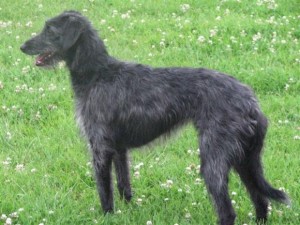
Greyhounds bred with terriers or collies may produce all sorts of tangly rug effects, whilst the presence of deerhound often provides a sort of ‘wiry’ look to the coat. We once had a Bedlington, greyhound and godknowswhat cross who managed to shed both long grey hairs and soft white ones absolutely everywhere. This produces small lurcher clones in every corner of the house (more of which another time). Grooming is even more important in such cases.
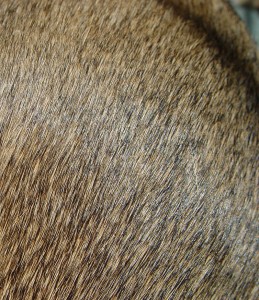
Even short-haired lurchers benefit from a regular brushing down. This keeps the coat clean and remove some of the hairs which would later be shed – before they clog the vacuum filter. With the longer haired lurcher, grooming also allows you to find missing lego, bubblegum, sticking plasters, houseplants and other detritus – maybe even that remote control for the DVD.
The downside is that with no real undercoat and thin skin, lurchers can need extra wrapping in winter (and on those family trips to the Arctic Circle to work out where all the penguins went*). It is now extremely easy to purchase a second ‘coat’, which has many benefits. Your expensive designer dog jacket will:
- absorb mud and stinky water much better than your dog, and cost more to clean;
- amuse passing pedestrians, who seem to have far more opinions about your dogs than they should have;
- come halfway undone and trail along after your dog, gathering additional mud;
- give your male dog hours of fun pulling it off because he doesn’t like the strap near his bits.
Also remember that lurchers are a Funny Shape, as someone put it. Standard dog coats will not fit, being either too tight over that deep chest or too loose around that narrow tummy. And lurchers who do zoomies require well-fastened coats, or you will find the two parting company in seconds.
It may sometimes be better to shove your lurcher into an old pullover and abandon dreams of style. Please remember that early experimental techniques such as spraying dogs with a layer of teflon, or covering them entirely in saddle-wax for three months of the year, are no longer recommended.
We did once consider using squirrel-fur coats for winter protection, in order to produce a lurcher which chased itself 24 hours a day, but we relented at the last minute.
*they’re at the Antarctic, silly.
Variations in hair/fur colouration deserve an illustrated essay in their own right, so we’ll ignore them for the moment. Unless you’re obsessed with adding highlights and blue-rinses, we consider whatever nature provides in the way of dog hair colour to be quite adequate. Brindled, merled, saddled, spotted and unicolour make no difference to the quality of the hair coat and what you find stuck in it (although we do love a brindle).
Important note for new lurcher owners: If you have a lurcher with saddleback markings, and he or she is gaining a lot of weight, do make sure that you haven’t been sold a porker.
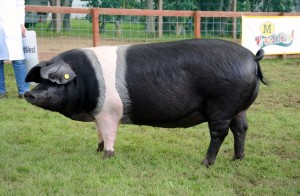
Which is where we come to the second half of today’s entry…
… And Things You Find In It
1) Fox Poo
It’s hardly fair to blame lurchers for this one, but they do have a magnetic attraction to the stuff. The classic sign is the ‘shoulder rub and slide’ on a piece of grass, which means that your dog is happily smearing odiferous fox droppings into its coat. If you’re fortunate, the fox will have been constipated. You will see the fox walking in an awkward manner and searching back-gardens for discarded packets of Ex-Lax. The poo will be firm and of limited interest. If not, as happens with so many urban foxes who eat random bin contents, the poo will be messy or slimy, and ideal for spreading.
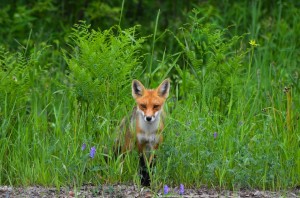
One added advantage of the ‘shoulder rub and slide’ is that the poo also gets on the underneath of the collar, but you miss that bit. You wash the dog itself, but then spend days wondering where the stink is coming from.
Rather obviously, pet shampoo is a must. Fox poo really does linger. Despite suggestions that tomato ketchup works wonders, a lurcher (and house) smeared with tomato ketchup is still a major cleaning job, so you might as well just deal with the fox poo directly.
2) Half the garden
‘Half the garden’ can be broken down into three easy sections:
2.1) Mud
The lurcher is God’s way of moving your flowerbed into your living room without divine intervention. Due to constant charges into the night and excited zoomies, lurchers are particularly efficient at churning up a mud path and then bringing it in to show you.
- Mud from your garden is normally just mud. Wash it off, rub it off with a towel or let it fall off. We rub it off because washing towels is easier than washing three dogs.
- Mud from the world outside your garden may not be just mud, and is therefore best washed/rubbed off straight after walkies. You don’t know what’s in it.
See also Lurchers for Beginners 3 – we were gardeners
2.2) Seeds That Are Harmless
Our dogs are constantly coming home covered in goosegrass (cleavers etc) seeds and other burr-like things which are quietly using the lurchers as a transport system to get away from their parents and breed somewhere else. Even goosegrass doesn’t want to stay with its mum all its life. Apart from invading your garden or sticking to your cardigans, most of these are Harmless.
2.3) Seeds That Can Be Horrid
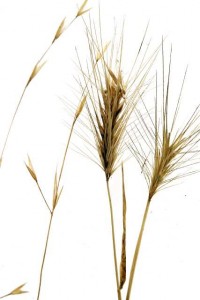
On a more serious note, do watch out for certain grass seeds, such as those of foxtail and similar grasses. Some of the hairy pointy ones can get caught in sensitive areas and burrow under the skin, hurting and eventually doing serious damage. Three key areas to check are:
- Between the pads of the paws. The seed can tangle with soft fur and go through the thinner skin there, causing pain and inflammation.
- The ears. If a grass seeds reaches the ear canal, it will do the same thing – working its way in towards the ear drum, again with nasty consequences if it gets embedded.
- The nose. They can get stuck up there after your dog has been snuffling in long grass.
Don’t panic, though. At the earliest stage, where you can see most of it on the surface, gently pull the seed out and clean the affected area. Best to get professional help if you think a seed may have got stuck somewhere sensitive and is really getting in there. Don’t leave it too late, because grass seeds don’t show up on X-rays and it’s hard to work out where they’re going.
Other things found in hair are relevant to most dog types, but we feel obliged to mention the common ones below.
3) Paint
Some lurchers, lacking an undercoat, try to make their own using Dulux. Our dogs have the unerring ability to find any bit of wall or skirting board we have recently painted and rub against it. Warm water, patience and occasionally a pair of scissors are the answer.
4) Flakes of Dandruff
There are two main brands of dandruff.
– Stationary dandruff, seborrhea, usually means dry skin, but we’re not vets. If your lurcher gets a lot of it, ask a professional. Human anti-dandruff shampoos are too harsh, but you can get doggie ones. And brushing can help move natural oils around and encourage oil production.
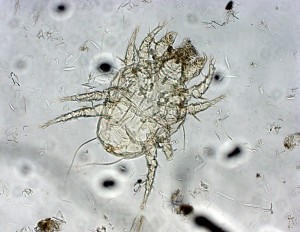
– Moving dandruff is much more exciting, and means that your lurcher has mites. Known as Cheyletiella, these mites amble about on the surface layer of the dog, raising flakes of skin. Very contagious, though not often serious. We’ve never had them, but they can be treated with various commercial preparations. They do need treating because they will spread to all the other animals, and can even hang around for a while on people.
5) Fleas
Fleas are great fun and can easily be trained to ride miniature bicycles and work long hours in flea circuses before getting unionised and demanding health care…
No, wait a moment, that’s in stories. Real fleas are a damned nuisance who make the dog itch, you itch and lay their eggs all over the place. They can spread tapeworms, and they start itchy patches which can later become sore and infected.
Dealing with the dog is relatively easy, with a range of specific products available. Dealing with the rest of house, dog bedding and other items can be achieved by pouring petrol over everything and living in a caravan in the garden for the rest of your life. If you have an allergy to petrol, try the more boring approach of washing the bedding, vacuuming madly and using safe flea treatments – dusting powders, topical applications and repellents.
Due to quantum physics and the speed of light at sea-level, or perhaps something else, flea infestations hang around for a while. There will be flea eggs, elite Special Forces fleas who can hide for longer in dense carpet undergrowth and so on. Keep on top of it, or you’ll be scratching again.
Do we need to say that we don’t mean the petrol bit? This is, of course, extremely unsafe, especially if your lurcher knows where the matches are kept…
6) Ticks
We don’t like ticks. Sheep-ticks and other varieties (such as deer ticks) are found on moorland, in long grass, bracken and some woodlands and gardens. As lurchers run around actively, often where you don’t want them to, ticks are worth a mention. The last one we found was on a tortoise, which was surprising as we didn’t realise that he knew any sheep, or that he went fell-walking. His circle of friends was clearly wider than we thought.
Ticks embed their mouthparts in your dog’s skin (or yours) and feed on the blood. When they’re full they drop off. Charming. They can be harmless, but some carry nasty bugs like Lyme Disease.
Never squeeze or put pressure on the main body of the tick, as they have a habit of throwing up. The blood and digestive juices which result can carry infection into the dog’s bloodstream (or even yours). Ticks are a pain. Despite various folk-lore suggestions, the best thing to do is to use a tick-removal tool or a pair of narrow-nosed pliers, grasping the tick around the forebody right behind the head.
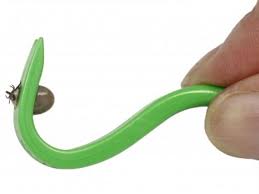
Check out somewhere like this site for actual advice:
Hmm – that last bit wasn’t very funny, was it, listeners? We considered adding jokes about how many sheep-ticks it takes to change a light-bulb and so on, but they didn’t quite work. So It’s Just Not Fur! has its limitations. We don’t get paid for writing this, you know. As always, don’t take our word for anything. Double-check it or find a friendly vet.
If you do have further questions about lurchers or longdogs, feel free to send them in. We’ll decide what to do next:
- If they’re interesting questions, we’ll answer them on here in our usual inadequate way. We may also be sarcastic or drift off topic, so you have been warned.
- If they’re serious medical questions, we’ll have no clue what to say and tell you that you’re on the wrong web-site. Most of our dogs reach old age by being stubborn, not because of our genius-level knowledge.
Next time: Weird odds & sods that didn’t fit into the articles. Sorry, what we meant to say was: A magical miscellany for your entertainment…


